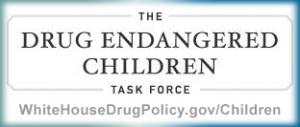Drug Endangered Children (DEC)

Overview
Originally Published: 06/14/2011
Post Date: 06/14/2011
Summary/Abstract
As part of the President's 2010 National Drug Control Strategy, the Department of Justice established the Federal Interagency Task Force on Drug Endangered Children to support the identification of model protocols, programming, and best practices.
Content
“A drug endangered child is a person, under the age of 18, who lives in or is exposed to an environment where drugs, including pharmaceuticals, are illegally used, possessed, trafficked, diverted, and/or manufactured and, as a result of that environment: the child experiences, or is at risk of experiencing, physical, sexual, or emotional abuse; the child experiences, or is at risk of experiencing, medical, educational, emotional, or physical harm, including harm resulting or possibly resulting from neglect; or the child is forced to participate in illegal or sexual activity in exchange for drugs or in exchange for money likely to be used to purchase drugs.” Federal Interagency Task Force for Drug Endangered Children (2010) As part of the President's 2010 National Drug Control Strategy, the Department of Justice established the Federal Interagency Task Force on Drug Endangered Children to support the identification of model protocols, programming, and best practices related to this issue. This Web site includes a compilation of related resources and a toolkit of promising practices to assist States, local, and tribal governments in identifying, responding to, and providing services for drug endangered children. Image of two police officers next to police car assisting children Background and History Stemming in part from the methamphetamine crisis, the Drug Endangered Children (DEC) movement began in the last decade to respond to the growing phenomenon of finding children living among the squalor of meth labs located in homes and other areas where children were living or playing. The children found in these situations were often severely harmed or neglected, and in many instances tested positive for drugs. To rescue these children, local DEC programs were created all over the country and a national DEC program was created in 2003. Since that time, the movement to identify and aid drug endangered children has expanded in scope and impact to include partners on the Federal, State, tribal and local levels. Through this collaboration, the definition of drug endangered children expanded beyond only those children confronted by meth, and it broadened to include children that faced dangerous exposure to any type of drug. The DEC movement also sought to assist parents/guardians with substance use disorders and help address family issues surrounding the problem. Around the country, the DEC movement has rescued thousands of children and led to the development of numerous programs that have coordinated the efforts of law enforcement, medical services, and child welfare services to ensure that drug-endangered children receive appropriate attention and care. Up to this point, however, a cohesive and coordinated federal response had been lacking. For this reason, an Interagency Task Force on Drug Endangered Children was formed. The Federal Interagency Task Force on Drug Endangered Children (DEC) is focused on gathering and producing educational resources (model protocols, programming and promising practices) that can aid law enforcement, child welfare workers, health and education professionals and children's advocates nationwide in protecting children and responding to their needs and the needs of their caregivers. By working together with its Federal, state and local partners, the Task Force aims to end this vicious cycle and By establishing these tools and promoting their use, Federal, state and local stakeholders will be better able to rescue, protect, and serve the most vulnerable victims of drug-related crimes. Research and Statistics Between 2002 and 2007, an estimated 2.1 million children in the U.S. (3.0%) lived with at least one parent who abused or was dependent on illicit drugs. Studies of children in foster care find that 40% to 80% of families involved with child welfare having substance abuse problems.





